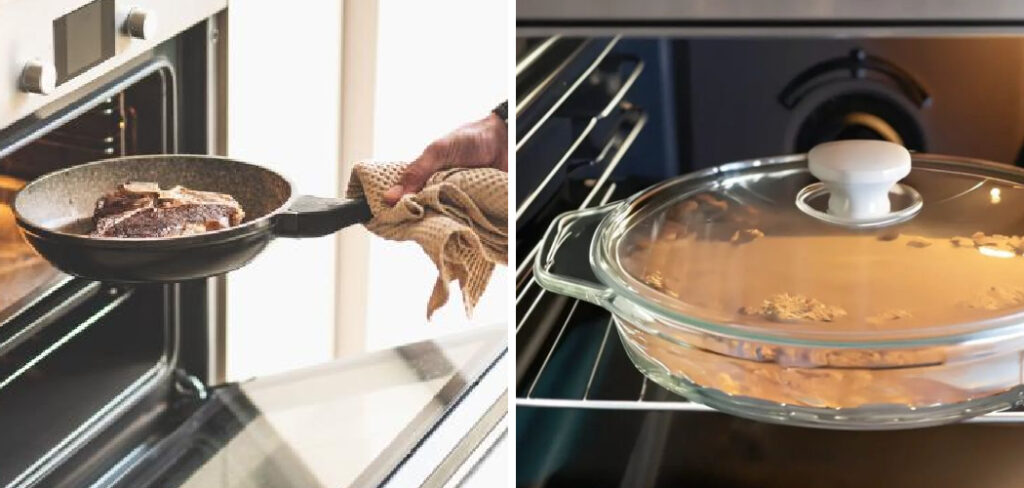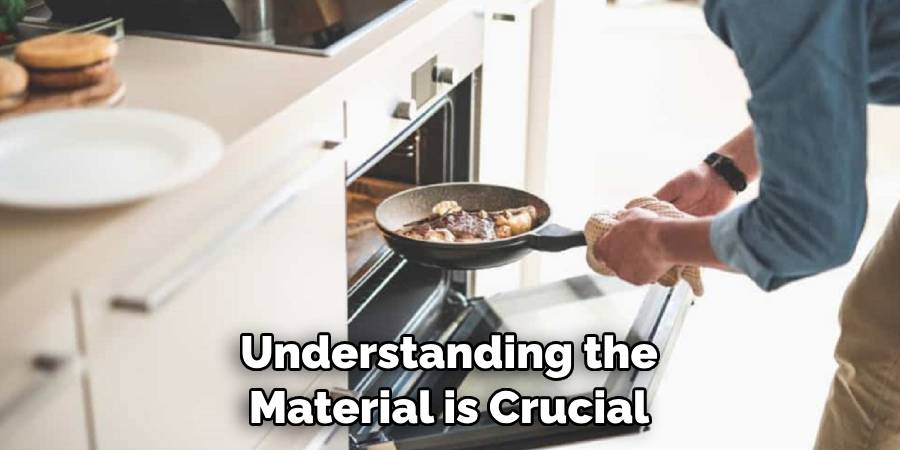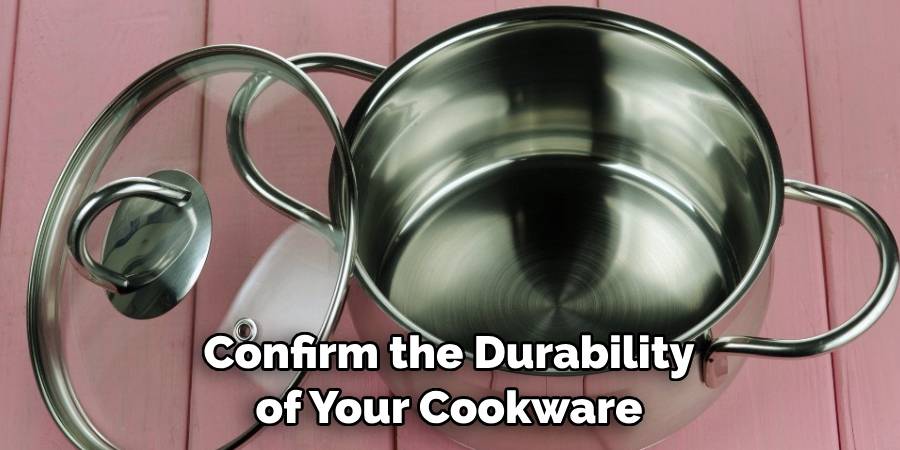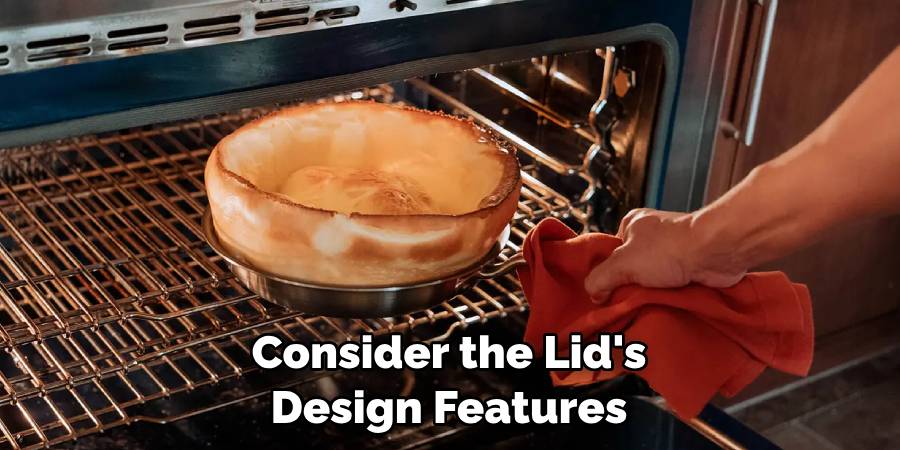Are you tired of guessing if your cookware lids are safe for use in the oven? Are you afraid of damaging your expensive pots and pans by placing them in the oven with the wrong lid?

When it comes to cooking, knowing whether your cookware, including lids, is oven-safe can significantly impact your culinary success.
Using the wrong lid type can lead to disasters like melting, warping, or releasing harmful chemicals. To ensure your cooking experience is safe and effective, it’s crucial to identify the materials and markings that indicate a lid’s suitability for oven use.
This guide on how to tell if a lid is oven safe, will provide essential tips and considerations to help you determine whether your lid can withstand the heat and durability required for oven cooking, ensuring your meals are prepared under the best conditions.
What Will You Need?
Before we dive into the details, here’s what you’ll need:
- The lid in question
- A steady hand to handle the lid
- Adequate lighting
Once you have these, let’s get started!
10 Easy Steps on How to Tell if a Lid is Oven Safe
Step 1: Check for Oven-Safe Symbols
Begin by examining the lid for any symbols or markings that indicate whether it is oven-safe. Look for a small emblem of an oven or a temperature range printed on the underside of the lid.
Manufacturers often include these symbols to guide you in making informed decisions about their cookware. If you find an oven-safe symbol, you’re on the right track! If there are no markings, proceed to the next step.
Step 2: Identify the Material
Next, determine the material from which the lid is made. Common materials include glass, metal, silicone, and plastic. Generally, glass and metal lids are more likely to be oven-safe compared to their plastic counterparts, which can melt or warp under high heat.
Research the specific material’s heat resistance or refer to the manufacturer’s guidelines for clarity.
Understanding the material is crucial in assessing whether it can endure the temperatures of your oven without failure. It’s always safer to choose a lid explicitly marked as oven-safe if in doubt.

Step 3: Inspect for Heat Resistance Ratings
Manufacturers provide heat resistance ratings for some lids, usually indicated on the packaging or product description. Check if your lid has any specified temperature limits. If these limits are provided, ensure they are compatible with the temperature you intend to use.
Remember that even if a lid is made from a heat-resistant material, exceeding its maximum temperature can still result in damage. If you cannot find a heat resistance rating, consider contacting the manufacturer for clarification to ensure you make a safe choice.
Step 4: Perform a Visual Inspection
Look closely at the lid for any signs of damage or wear. Cracks, chips, or warping can indicate that the lid may not handle oven heat well. If the lid appears compromised, avoiding using it in the oven is best to prevent potential hazards.
A well-maintained lid without visible damage is more likely to withstand the conditions of cooking in the oven effectively. If you spot any issues, consider replacing the lid with a new one that is confirmed to be oven-safe.
Step 5: Conduct a Hot Water Test
If you still need to decide about the lid’s oven safety, consider performing a hot water test as a final check. Boil a pot of water and carefully submerge the lid in the hot water for a few minutes.
Monitor how the lid reacts to the heat. If the lid remains intact and shows no signs of warping or melting after this exposure, it’s also likely to withstand oven temperatures.
However, if you notice any changes or damage, avoiding using it in the oven altogether is best. Always prioritize safety and confirm the durability of your cookware before putting it to the test.

Step 6: Consult the Manufacturer’s Website
If you are still in doubt about whether your lid is oven-safe, another practical approach is to visit the manufacturer’s website. Most reputable brands provide detailed product information, including cooking guidelines, safety instructions, and specific temperature limits.
Look for a section dedicated to product specifications or frequently asked questions. If the information is unavailable, consider reaching out to their customer support for direct assistance.
This step ensures you have the most accurate and reliable information regarding your lid’s oven safety, helping you make an informed decision.
Step 7: Look for User Reviews and Recommendations
Another useful method for assessing the oven safety of your lid is to check online user reviews and recommendations. Websites that sell cookware often feature customer feedback that can provide insights into others’ experiences with the same lid.
Look for comments that specifically mention the lid’s performance in the oven. If multiple users have successfully used the lid in high temperatures without issues, it’s a reassuring sign of its safety. Conversely, if there are numerous warnings about melting or warping, this could indicate a potential risk.
Trusting the experiences of other users can guide you toward safer choices in the kitchen.
Step 8: Understand the Lid’s Design
Consider the lid’s design features, as some designs are inherently more suitable for oven use than others. Lids with thicker edges are often better equipped to handle high temperatures than those that are thin and lightweight. Additionally, lids that have a tight-fitting design can trap heat efficiently, promoting even cooking.
Be cautious of decorative lids that may contain materials that are not heat resistant, such as plastic or non-oven-safe embellishments. Recognizing how the lid’s design aligns with your cooking method can give further insight into its oven safety.

Step 9: Test with a Lower Temperature
If you’ve followed the previous steps but still have reservations about the lid’s oven safety, consider a cautious approach by testing it at a lower temperature.
Preheat your oven to moderate heat, typically around 300°F (150°C), and place the lid alongside a familiar dish in the oven.
Monitor the lid closely for any signs of damage or deformation during this initial exposure. If the lid holds up well at this lower temperature, it can provide reassuring evidence of its oven-safe capabilities.
However, if any issues arise, it is best to err on the side of caution and avoid using the lid in higher temperatures altogether.
Step 10: Consider Alternative Cookware
If after all the inspections and tests you’re still uncertain about the lid’s oven safety or if you encounter any issues, consider alternative cookware.
There are many options designed specifically for oven use that ensure safety and performance. Look for materials such as stainless steel, cast iron, or heat-resistant glass that are inherently safer for oven cooking.
Selecting a pot or pan with an accompanying lid that’s certified oven-safe simplifies your cooking process and reduces the risk of accidents. Prioritizing safety and choosing reliable cookware can enhance your culinary experiences and give you peace of mind in the kitchen.
By following these steps, you can confidently determine whether a lid is oven-safe and make informed decisions when using it for cooking.
5 Things You Should Avoid
- Ignoring Labels and Instructions: Always check for any labeling or manufacturer’s instructions regarding oven safety. Assuming a lid is safe due to its material can lead to mishaps; labels can provide crucial information.
- Relying Solely on Visual Appearance: While a lid may look robust and well-made, its appearance doesn’t always indicate its true heat resistance. Avoid making judgments based solely on looks without verifying other factors such as material specifications.
- Overlooking Temperature Limits: Different materials have different temperature thresholds. Avoid disregarding the specified maximum temperatures for various lid types. Using a lid beyond its limits can lead to damage or even dangerous situations.
- Neglecting the Importance of Manufacturer Support: If you’re unsure about your lid’s safety, don’t overlook the importance of contacting the manufacturer. Failing to seek clarification can lead to using a lid that may not be suitable for oven use.
- Using Unverified User Sources: Be cautious when considering online reviews or user-generated content that lacks verification. Relying on unsubstantiated claims from non-expert sources can mislead you regarding the safety of your cookware.
By avoiding these actions, you can reduce the risks of using oven lids and ensure a safer cooking experience.

Conclusion
How to tell if a lid is oven safe involves carefully evaluating various factors, including material composition, manufacturer guidelines, user experiences, and design characteristics.
Always start by inspecting labels and instructions that accompany the lid, as they provide crucial insights.
Researching the manufacturer’s website can further clarify safety specifications and reach out for support if necessary.
Additionally, user reviews can be a valuable resource in understanding the practical use and performance of the lid at high temperatures.
If uncertainty lingers, conducting a test at a lower temperature can offer further reassurance.
Ultimately, making informed decisions based on a thorough understanding of the lid’s features will help ensure safe and successful cooking in the oven. Prioritizing safety protects your cookware and enhances your overall culinary experience.
Professional Focus
Angela Ervin, a former interior designer turned blogger, specializes in kitchen design and renovations. Through her website, she blends her passion for cooking with design expertise, sharing practical and creative ideas. Known for balancing functionality and beauty, Angela’s insightful content has made her a trusted voice in home design and lifestyle.
About the Author
Angela Ervin, an experienced interior designer and blogger, combines her passion for kitchen renovations with storytelling. Living in Petersburg with her family, she enjoys cooking and testing her projects firsthand. Known for her humor and relatable style, Angela shares creative, functional design insights through her content, making her a trusted voice in home design.
Education History
University: Virginia Commonwealth University
Degree: Bachelor of Fine Arts (BFA) in Interior Design
- Angela’s education at VCU focused on mastering core interior design principles, including spatial planning, color theory, materials selection, and sustainable design practices.
- She gained hands-on experience through studio projects and collaborative design exercises, which honed her ability to create functional and aesthetically pleasing environments.
- Her coursework also emphasized problem-solving and practical applications of design, preparing her for real-world projects like her self-directed kitchen renovations.
- The program’s strong foundation in both technical skills and creative expression shaped Angela’s ability to seamlessly integrate form and function in her work.


